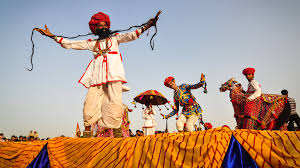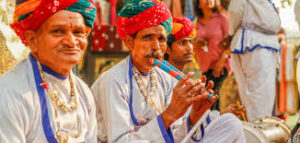Rajasthani Culture: A Tapestry of Tradition, Color, and Royalty From magnificent forts and palaces to colorful festivals and folk traditions, Rajasthani culture is a blend of royal heritage, traditional values, and artistic brilliance. Nestled in the heart of the Thar Desert, Rajasthan has preserved its unique identity through its architecture, food, attire, music, and way of life.
Traditional Clothing: A Splash of Colors

One of the most striking features of Rajasthani culture is its traditional attire. The people of Rajasthan wear vibrant, colorful clothes, which serve both aesthetic and practical purposes—bright colors help offset the monotony of the desert surroundings.
Men usually wear dhoti, kurta, and safa (turban), which varies in color and style based on region and occasion. The mustache is often worn with pride, symbolizing masculinity and honor.
Women adorn themselves in ghagra, choli, and odhani (veil), decorated with mirror work, embroidery, and gota patti. Jewelry, from bangles and anklets to nose rings and borlas (forehead ornaments), holds cultural and religious significance.
Art and Handicrafts
Rajasthan is a hub for traditional Indian handicrafts and folk arts. Skilled artisans have passed down their crafts through generations.
Block printing from Sanganer and Bagru, blue pottery from Jaipur, and leatherwork from Jodhpur are world-famous.
Miniature paintings, especially from the Mewar and Marwar schools, depict stories from mythology and royal courts.
The state is also famous for puppet shows (Kathputli), a popular form of storytelling.
Architecture: A Royal Legacy

Rajasthan’s architecture reflects the valor and taste of its kings and queens. Grand forts and palaces rise dramatically from desert landscapes, telling tales of glory and resistance.
Forts like Mehrangarh (Jodhpur), Amber (Jaipur), and Jaisalmer Fort stand as timeless symbols of Rajput bravery.
Palaces such as City Palace (Udaipur), Hawa Mahal (Jaipur), and Umaid Bhawan (Jodhpur) show intricate designs, marble carvings, and royal lifestyle.
Havelis in cities like Shekhawati boast elaborate frescoes and lattice work, blending Mughal and Rajput styles.Folk Music and Dance
Music and dance are integral to Rajasthani life and rituals, often performed during festivals, weddings, and gatherings.
Ghoomar, a traditional dance performed by women in long swirling skirts, and Kalbeliya, the dance of the snake charmer community, are globally recognized.
Bhavai (women balancing pots), Chari (lamp dance), and Terah Taali (dance with thirteen cymbals) are unique and captivating Folk music features instruments like the sarangi, dholak, and algoza, with hauntingly beautiful ballads sung by communities like the Manganiyars and Langas.
Festivals and Fairs
Rajasthan celebrates a wide array of festivals with unmatched zeal and grandeur. These events reflect its spiritual devotion, cultural richness, and communal harmony.
Desert Festival (Jaisalmer), Camel Festival (Bikaner), and Pushkar Fair are major tourist attractions.
Religious festivals like Teej, Gangaur, Diwali, and Holi are celebrated with processions, dances, and rituals.
Mewar Festival in Udaipur and Marwar Festival in Jodhpur showcase traditional music, arts, and royal processions.
Cuisine: A Spicy Delight
Rajasthani cuisine is shaped by the region’s arid climate and limited water supply, resulting in food that is spicy, flavorful, and long-lasting.
Famous dishes include Dal Baati Churma, Gatte ki Sabzi, Ker Sangri, and Laal Maas.
Sweets like Ghewar, Balushahi, and Mawa Kachori are integral to celebrations.
Pickles, chutneys, and dried preparations (like papads) are also a staple part of Rajasthani meals.
Language and Literature
The primary language spoken is Rajasthani, with dialects like Marwari, Mewari, Shekhawati, and Hadoti. Folk tales and poems passed orally over centuries speak of bravery, love, and spiritualism.
Legendary tales of Amar Singh Rathore, Pabuji, and Balla and Meera Bai remain deeply rooted in local consciousness.
The works of poet-saints like Meera Bai and Dadu Dayal continue to inspire devotion and cultural pride.
Social and Religious Traditions
Rajasthani society places great importance on customs and community bonds. Hospitality is a key part of their culture—“Padharo Mhare Desh” is not just a phrase but a heartfelt invitation.
Weddings are grand, filled with rituals like Mehndi, Haldi, and Pheras, often extending over several days.
The influence of Hinduism, Jainism, and folk deities (like Gogaji and Tejaji) can be seen in temples, rituals, and everyday life.
Conclusion
Rajasthani culture is a kaleidoscope of color, tradition, and history. Despite modernization, the state has proudly retained its roots and continues to thrive as a beacon of India’s rich cultural heritage. Whether it’s the soulful music echoing across sand dunes, the swirl of Ghoomar in village fairs, or the royal charm of majestic palaces—Rajasthan leaves an unforgettable impression on every visitor. It is a place where the past lives vividly in the present, and every tradition tells a story worth celebrating.
